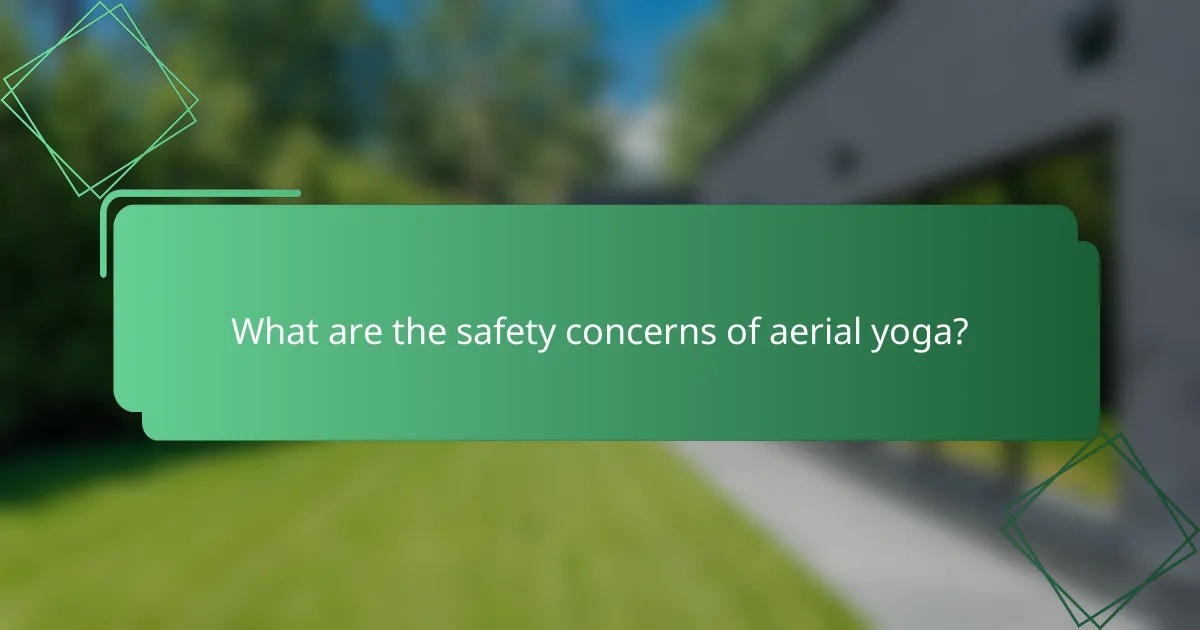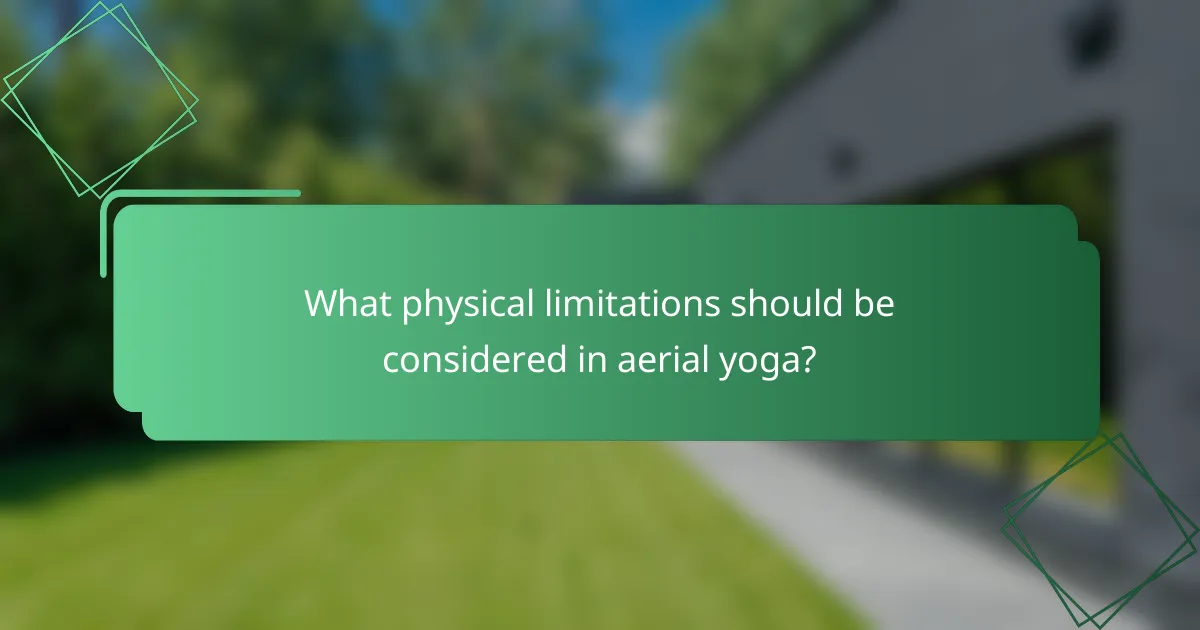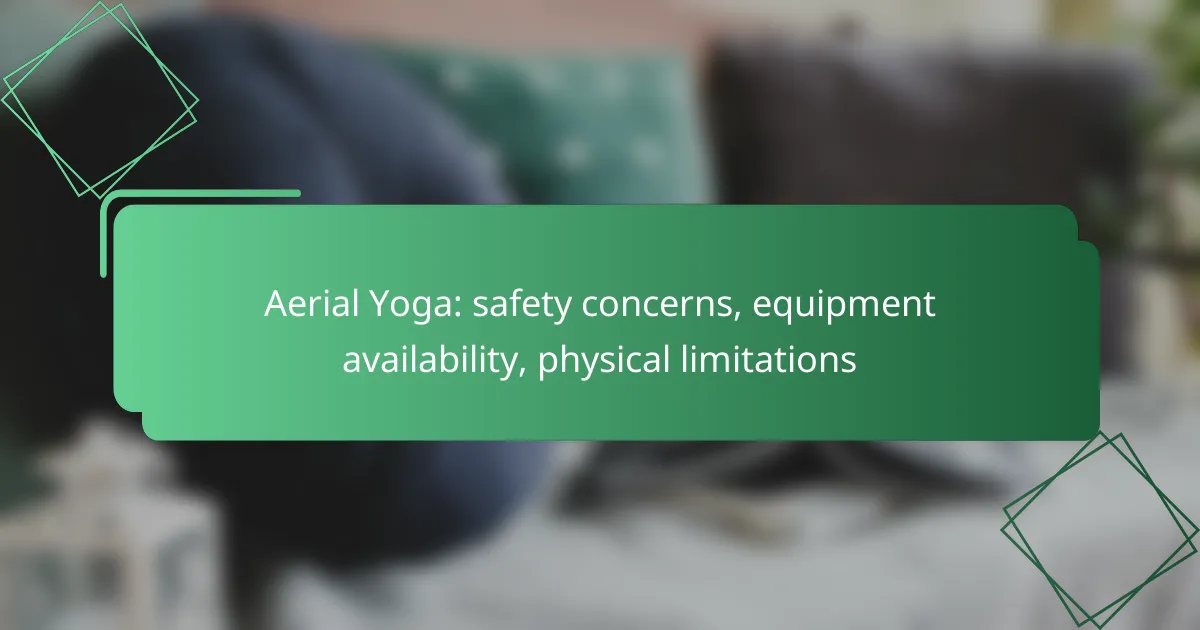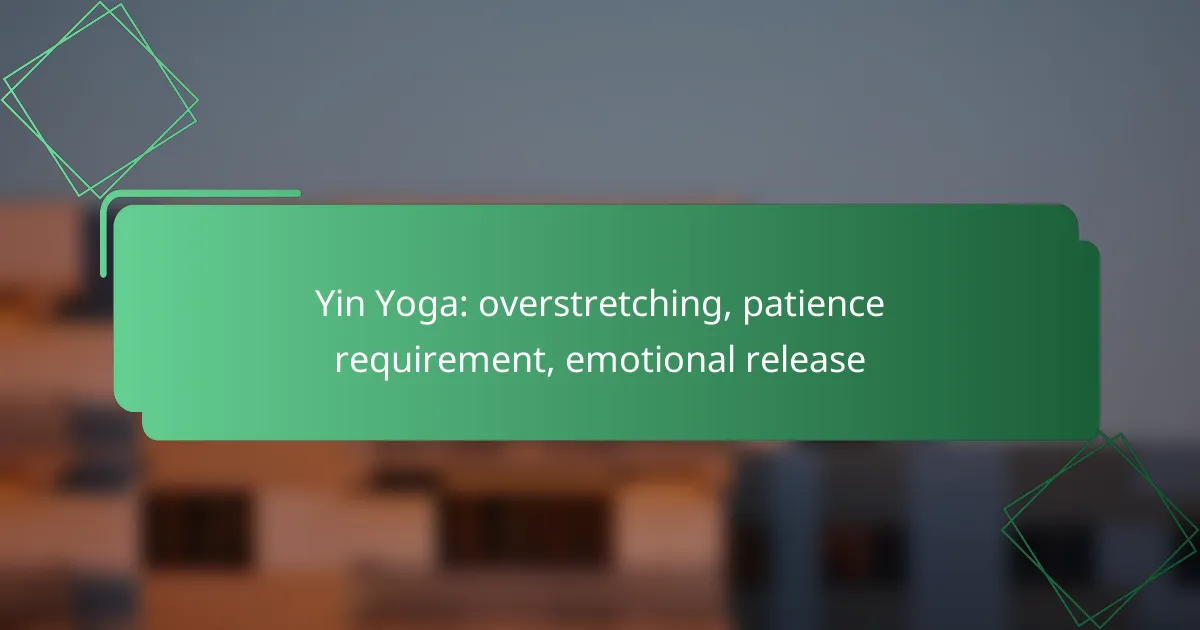Aerial yoga offers a unique blend of traditional yoga and acrobatics, but it also comes with specific safety concerns that practitioners must consider. Key issues include the risk of falls, joint strain, and the importance of using high-quality equipment that meets safety standards. Additionally, understanding one’s physical limitations is essential to ensure a safe and enjoyable practice.

What are the safety concerns of aerial yoga?
Aerial yoga presents several safety concerns that practitioners should be aware of, including the risk of falls, joint strain, equipment malfunction, and the qualifications of instructors. Understanding these issues can help ensure a safer practice and enhance the overall experience.
Risk of falls
The risk of falls in aerial yoga is significant due to the nature of practicing poses suspended in the air. Practitioners may lose balance or misjudge their movements, leading to potential injuries. To mitigate this risk, beginners should start with basic poses close to the ground and gradually progress as they build confidence and strength.
Using a crash mat or practicing in a space with ample padding can also help reduce injury severity in case of a fall. Always ensure that the aerial silks or hammocks are properly secured before beginning any session.
Joint strain
Joint strain is a common concern in aerial yoga, particularly for those with pre-existing conditions or limited flexibility. The unique positions can place excessive stress on joints, especially the shoulders, hips, and knees. Practitioners should listen to their bodies and avoid pushing into painful ranges of motion.
Incorporating proper warm-ups and cool-downs can help prevent strain. It’s advisable to consult with a healthcare professional before starting aerial yoga, especially for individuals with prior injuries or chronic pain.
Equipment malfunction
Equipment malfunction poses a serious safety risk in aerial yoga. This can include issues with the aerial silks, hammocks, or rigging systems. Regular inspections of the equipment for wear and tear are essential to ensure safety during practice.
Practitioners should only use equipment that meets safety standards and is designed specifically for aerial yoga. If possible, inquire about the maintenance practices of the studio to ensure that the equipment is regularly checked and replaced as needed.
Instructor qualifications
The qualifications of instructors play a crucial role in ensuring a safe aerial yoga experience. Instructors should have specialized training in aerial yoga techniques and safety protocols. This knowledge enables them to provide appropriate guidance and modifications for students of varying skill levels.
Before joining a class, it’s beneficial to research the instructor’s credentials and experience. Look for certifications from recognized aerial yoga organizations, which can indicate a commitment to safety and effective teaching methods.

How to choose safe aerial yoga equipment?
Choosing safe aerial yoga equipment involves selecting high-quality materials, ensuring adequate weight capacity, and verifying safety certifications. These factors are crucial for preventing accidents and ensuring a secure practice.
Material quality
Material quality is fundamental in aerial yoga equipment, as it directly affects durability and safety. Look for fabrics like nylon or polyester that are tear-resistant and can withstand significant wear and tear. Additionally, ensure the material is breathable to enhance comfort during practice.
Check for reinforced stitching and secure seams, as these features contribute to the overall strength of the equipment. Avoid low-quality materials that may degrade quickly or pose a risk during use.
Weight capacity
Weight capacity is a critical consideration when selecting aerial yoga equipment. Most aerial silks and hammocks have a weight limit ranging from around 200 to 600 pounds, depending on the design and manufacturer. Always choose equipment that exceeds your body weight to ensure safety during practice.
Be mindful of the combined weight if multiple users will be using the equipment simultaneously. It’s advisable to consult the manufacturer’s specifications to confirm the appropriate weight capacity for your needs.
Safety certifications
Safety certifications provide assurance that aerial yoga equipment meets established safety standards. Look for products that have been tested and certified by recognized organizations, such as the International Organization for Standardization (ISO) or similar bodies relevant to your region.
Checking for safety certifications can help you avoid subpar equipment that may not have undergone rigorous testing. Always prioritize certified products, as they are more likely to provide a safe and reliable experience during your aerial yoga sessions.

What physical limitations should be considered in aerial yoga?
When practicing aerial yoga, it’s crucial to consider individual physical limitations such as pre-existing injuries, flexibility, and strength levels. These factors can significantly impact safety and the overall experience in aerial yoga classes.
Pre-existing injuries
Individuals with pre-existing injuries should approach aerial yoga with caution. Conditions such as back pain, joint issues, or recent surgeries can be exacerbated by the demands of aerial poses. Consulting with a healthcare professional before starting is advisable to ensure safety and to identify modifications that may be necessary.
Instructors should be informed of any injuries so they can provide appropriate adjustments and alternatives during the class. Avoiding certain poses that strain affected areas is essential for preventing further injury.
Flexibility requirements
Aerial yoga often requires a certain level of flexibility, particularly in the hips, hamstrings, and shoulders. Beginners may find some poses challenging if they lack flexibility, which could lead to discomfort or injury. Gradual progression through stretches and poses can help improve flexibility over time.
It’s beneficial to incorporate regular stretching routines outside of class to enhance flexibility. Participants should listen to their bodies and avoid pushing themselves into positions that feel painful or uncomfortable.
Strength levels
Strength is a critical component of aerial yoga, as it supports the body while suspended in the air. Those with lower strength levels may struggle with certain poses, particularly those requiring core stability and upper body strength. Building strength through complementary exercises can enhance performance in aerial yoga.
Beginners should focus on foundational poses that build strength gradually. Working with an instructor can provide guidance on appropriate modifications and progressions to safely develop strength for more advanced aerial techniques.

Where to find aerial yoga classes in major cities?
Aerial yoga classes are widely available in major cities, often offered by specialized studios and fitness centers. These classes typically incorporate hammocks or silks to enhance traditional yoga practices, making them accessible for various skill levels.
Los Angeles studios
In Los Angeles, several studios offer aerial yoga classes, catering to different experience levels. Popular options include Air Aerial Fitness, known for its welcoming atmosphere, and YogaWorks, which provides a variety of aerial classes throughout the week.
When selecting a studio, consider checking their schedules online for class availability and any introductory offers. Many studios also provide rental equipment, but it’s advisable to confirm this beforehand.
New York City options
New York City boasts numerous aerial yoga studios, such as Sky Ting Yoga and Pure Yoga, both offering diverse class formats. These studios often feature experienced instructors who can guide beginners through the basics.
Before attending a class, review the studio’s policies on equipment use and any prerequisites for participation. Many studios recommend booking in advance due to limited class sizes.
Chicago class listings
In Chicago, aerial yoga can be found at studios like Zen Yoga Garage and The Yoga Shop, which provide a range of classes from beginner to advanced levels. These locations often emphasize safety and proper technique.
Check the class descriptions for specifics on what to expect and whether any equipment is included. It’s also beneficial to arrive early to familiarize yourself with the space and equipment.

What are the prerequisites for aerial yoga?
To practice aerial yoga safely, individuals should have a basic fitness level and some prior yoga experience. These prerequisites help ensure that participants can handle the physical demands of the practice while minimizing the risk of injury.
Basic fitness level
Aerial yoga requires a certain level of physical fitness to perform poses safely and effectively. Participants should be able to support their body weight and have a good range of motion in their joints. Strength in the core, arms, and legs is particularly important for maintaining stability while suspended in the air.
Before starting aerial yoga, it’s advisable to engage in regular physical activities such as strength training, Pilates, or traditional yoga. These activities can help build the necessary strength and flexibility, making the transition to aerial yoga smoother and safer.
Prior yoga experience
Having prior yoga experience is beneficial for anyone looking to start aerial yoga. Familiarity with basic yoga poses and breathing techniques can enhance the practice and help individuals adapt to the unique challenges of working with aerial silks or hammocks. Understanding alignment and body awareness from traditional yoga can significantly reduce the risk of injury.
For those new to yoga, it may be helpful to complete a few beginner classes before attempting aerial yoga. This foundational knowledge will provide a better understanding of body mechanics and help build confidence when practicing in the air.

How to assess instructor qualifications for aerial yoga?
To assess instructor qualifications for aerial yoga, check their certifications, experience, and teaching style. Look for instructors who have completed recognized training programs and have a solid background in both yoga and aerial techniques.
BODY REQUIREMENTS
When considering body requirements for aerial yoga, it’s essential to evaluate your physical condition and any limitations. Aerial yoga can be demanding, so individuals should be generally fit and free from serious injuries or conditions that could be exacerbated by the practice.
Common physical limitations include issues with balance, flexibility, or strength. If you have concerns, consult a healthcare professional before starting. It’s also beneficial to communicate any limitations to your instructor, who can provide modifications or alternative poses.
DEPTH & COVERAGE
Depth and coverage in aerial yoga involve understanding the techniques and safety measures necessary for practice. Instructors should be well-versed in aerial apparatuses and their proper use, ensuring that students are safely supported while performing poses.
Consider the instructor’s ability to explain and demonstrate poses clearly. They should also emphasize safety protocols, such as proper warm-ups and cool-downs, to prevent injuries. A good instructor will adapt classes to suit varying skill levels, ensuring everyone can participate safely.
When assessing depth and coverage, look for classes that offer a mix of foundational and advanced techniques. This variety helps students progress at their own pace while maintaining safety and enjoyment.










